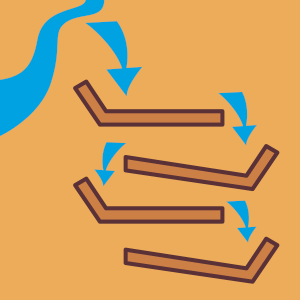Material required
- An Abney level or line level (If you have a line level and a measuring tape available, this is also a good way to measure the slope of your land.)
- Pegs or stones
- String (not strictly necessary but useful)
- Measuring tape, a graded stick, or something for measuring
- Wooden triangular right-angle frame (or something to measure 90 degrees angles)
- Instrument to measure the slope: some examples of tools you can use are an Abney level, a line or a spirit level.
Click here to see one way of measuring the slope with a line level.
Steps of implementation
Water-spreading bunds are used to spread water that reaches the floodplain, either because it has been diverted from a watercourse or because the water has naturally reached the floodplain. The earthen bunds slow down the runoff and let it spread over the cultivated land, thus they increase the infiltration rate.
1. Design: There are two potential designs of the water spreading bunds depending on the slope of the land on which this technique is applied. Some other factors to take into account when choosing the design are the quantity of water that will reach the structure, the soil type and the availability of labour.
-
- For slopes of <0.5%: the layout consists of straight open-ended bunds placed across the slope. These are meant to spread and slow down the flow of water. They are usually situated at around 50 m apart and it is recommended that they overlap so the flow discharged by the bund above is intercepted by the one below.
- For slopes of >0.5%: the structure consists of a series of graded bunds situated along a ground slope of 0.25%, and each successive bundle is graded downslope starting from the opposite end. On the upper end, each bund is provided with a short upslope wing that collects the flow from the bund above and canalises it towards the bund downslope. The spacing between the bunds depends on the slope.

Source
2. Construction: In both designs, the bund cross section is recommended to be a maximum of 100 m long and 60cm high with a base width of 4.1m, and a top width of 50cm. When preparing the design of the water spreading bunds intervention, the calculation of the catchment/cultivation area ratio is not necessary, and not easy to achieve. This is because, firstly, the floodwater is not impounded, but instead continuously flows through the bunds, and secondly, because only part of a watercourse flow is canalised towards the cultivated area, the amount of water utilised is difficult to estimate.
3. Maintenance: As in all other water harvesting systems that involve earthen structures, maintenance is crucial, especially in the first seasons when the buds are not yet consolidated. It is therefore recommended to carefully inspect the areas after all runoff events. The risk of breaching diminishes over time because bunds have consolidated, and vegetation has developed, helping to bind the soil together. Nevertheless, heavy floods can happen at any time and ruptures can occur at any stage.
For a detailed step-by-step please see the instructions given here.
This intervention contributes to:



1. Water spreading bunds in Khor Arbaat, Sudan
Description
Water harvesting traditions are widespread in Sudan and the example of Khor Arbaat is one of many. Located in the Red Sea Hills of North Eastern Sudan, Khor Arbaat has a mountainous and hilly terrain with wadis. Water harvesting is based on a simple and inexpensive diversion of runoff water by ridges of earth or rocks from the catchment area to a cropping basin. Diversion of the water basin is also made through the introduction of contour bunds as a source of irrigation for free and crop/fodder planting. Domestic water supply is from hand-dug wells. Irrigation is supplied by building earth embarkments across wadis to spread the water outwards. Large crescent-shaped bunds are built on the wadi beds and planted with sorghum. The technique is developed by the Beja, the dominant social group in the area, which is highly dependent on transhumance and farming. The Beja developed this technique that is flexible and fits in with the labour requirements and social structure. Without similar indigenous techniques of water harvesting, life in regions like North-Eastern Sudan would be impossible.




